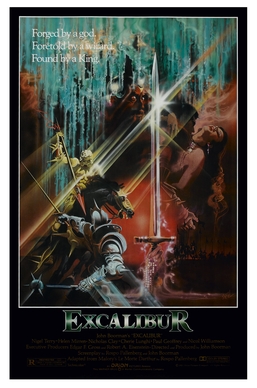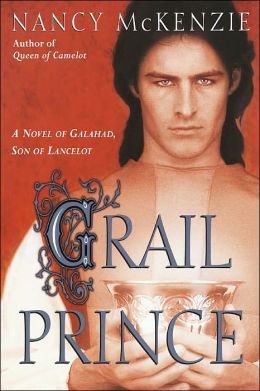
Guinevere, also often written in Modern English as Guenevere or Guenever, was, according to Arthurian legend, an early-medieval queen of Great Britain and the wife of King Arthur. First mentioned in literature in the early 12th century, nearly 700 years after the purported times of Arthur, Guinevere has since been portrayed as everything from a fatally flawed, villainous, and opportunistic traitor to a noble and virtuous lady. The variably told motif of abduction of Guinevere, or of her being rescued from some other peril, features recurrently and prominently in many versions of the legend.

Gawain, also known in many other forms and spellings, is a character in Arthurian legend, in which he is King Arthur's nephew and one of the premier Knights of the Round Table. The prototype of Gawain is mentioned under the name Gwalchmei in the earliest Welsh sources. He has subsequently appeared in many Arthurian tales in Welsh, Latin, French, English, Scottish, Dutch, German, Spanish, and Italian, notably as the protagonist of the Middle English poem Sir Gawain and the Green Knight. Other works featuring Gawain as their central character include De Ortu Waluuanii, Diu Crône, Ywain and Gawain, Golagros and Gawane, Sir Gawain and the Carle of Carlisle, L'âtre périlleux, La Mule sans frein, La Vengeance Raguidel, Le Chevalier à l'épée, Le Livre d'Artus, The Awntyrs off Arthure, The Greene Knight, and The Weddynge of Syr Gawen and Dame Ragnell.

Lancelot du Lac, alternatively written as Launcelot and other variants, is a popular character in Arthurian legend's chivalric romance tradition. He is typically depicted as King Arthur's close companion and one of the greatest Knights of the Round Table, as well as a secret lover of Arthur's wife, Guinevere.

Mordred or Modred is a major figure in the legend of King Arthur. The earliest known mention of a possibly historical Medraut is in the Welsh chronicle Annales Cambriae, wherein he and Arthur are ambiguously associated with the Battle of Camlann in a brief entry for the year 537. Medraut's figure seemed to have been regarded positively in the early Welsh tradition and may have been related to that of Arthur's son. As Modredus, Mordred was depicted as Arthur's traitorous nephew and a legitimate son of King Lot in the pseudo-historical work Historia Regum Britanniae, which then served as the basis for the subsequent evolution of the legend from the 12th century. Later variants most often characterised Mordred as Arthur's villainous bastard son, born of an incestuous relationship with his half-sister, the queen of Lothian or Orkney named either Anna, Orcades, or Morgause. The accounts presented in the Historia and most other versions include Mordred's death at Camlann, typically in a final duel, during which he manages to mortally wound his own slayer, Arthur. Mordred is usually a brother or half-brother to Gawain; however, his other family relations, as well as his relationships with Arthur's wife Guinevere, vary greatly.

The Lady of the Lake is a title used by multiple characters in the Matter of Britain, the body of medieval literature and mythology associated with the legend of King Arthur. As either actually fairy or fairy-like yet human enchantresses, they play important roles in various stories, notably by providing Arthur with the sword Excalibur, eliminating the wizard Merlin, raising the knight Lancelot after the death of his father, and helping to take the dying Arthur to Avalon after his final battle. Different Ladies of the Lake appear concurrently as separate characters in some versions of the legend since at least the Post-Vulgate Cycle and consequently the seminal Le Morte d'Arthur, with the latter describing them as members of a hierarchical group, while some texts also give this title to either Morgan or her sister.

Excalibur is a 1981 epic medieval fantasy film directed, cowritten and produced by John Boorman, that retells the legend of King Arthur and the knights of the Round Table, based loosely on the 15th-century Arthurian romance Le Morte d'Arthur by Thomas Malory. It stars Nigel Terry as Arthur, Nicol Williamson as Merlin, Nicholas Clay as Lancelot, Cherie Lunghi as Guenevere, Helen Mirren as Morgana, Liam Neeson as Gawain, Gabriel Byrne as Uther and Patrick Stewart as Leondegrance. The film is named after the legendary sword of King Arthur that features prominently in Arthurian literature. The film's soundtrack features the music of Richard Wagner and Carl Orff, along with an original score by Trevor Jones.
Morgause is a popular variant of the figure of the Queen of Orkney, an Arthurian legend character also known by various other names and appearing in different forms of her archetype. She is notably the mother of Gawain and often also of Mordred, both key players in the story of her brother King Arthur and his downfall.
Maleagant is a villain from Arthurian legend. In a number of versions of a popular episode, Maleagant abducts King Arthur’s wife, Queen Guinevere, necessitating her rescue by Arthur and his knights. The earliest surviving version of this episode names the abductor Melwas; as Maleagant, he debuts as Lancelot's archenemy in Chrétien de Troyes' French romance Lancelot, the Knight of the Cart. However, all surviving versions seem to be later adaptations of a stock narrative of significantly earlier provenance.

In Arthurian legend, Ywain, also known as Yvain and Owain among other spellings, is a Knight of the Round Table. Tradition often portrays him as the son of King Urien of Gorre and of either the enchantress Modron or the sorceress Morgan le Fay. The historical Owain mab Urien, the basis of the literary character, ruled as the king of Rheged in Britain during the late-6th century.
Douglas Clegg is an American horror and dark fantasy author, and a pioneer in the field of e-publishing. He maintains a strong Internet presence through his website.

The Mists of Avalon is a 2001 television miniseries based on the 1983 novel of the same title by Marion Zimmer Bradley. Produced by American cable channel TNT, adapted by Gavin Scott, and directed by Uli Edel, the series retells Arthurian legend from the perspectives of Morgan le Fay and other women of the tale. The first episode was the highest-rated original film on basic cable in the summer of 2001.

The Knight of the Sacred Lake is a historical fantasy novel by Rosalind Miles. It was first published in 2000 by Simon & Schuster in the UK followed by Crown Books in the US. The book is a retelling of the Arthurian legend and follows the lives of Queen Guinevere, consort of King Arthur and her struggles with the king's nephews Agravain and Gawain; the queen is torn between her love for her husband, her land, and her lover, Lancelot. The book was part of a series, The Guinevere Novels, and was followed by The Child of the Holy Grail. Reviewing the book, Publishers Weekly described it as "a lush, feminist take on the English epic".

The Winter King: A Novel of Arthur is the first novel of the Warlord Chronicles trilogy by Bernard Cornwell, originally published in the UK in 1995 by Penguin Group. The book is based on characters and plot elements from Arthurian myth, but considerably changed and re-worked.

Queen of Camelot is an Arthurian-legend based novel shown through the viewpoint of Queen Guinevere. It is a combination of two of Nancy McKenzie's previous books The Child Queen and The High Queen. She states in the foreword that she originally intended the novels to be combined, but they were split at the time of publication because of their length.

Grail Prince, a 2003 novel by American author Nancy McKenzie written in the tradition of Arthurian legends, recounts a version of Galahad's quest for the Holy Grail. The novel is a sequel to McKenzie's Queen of Camelot (2002).

Arthur Rex: A Legendary Novel is a 1978 novel by American author Thomas Berger. Berger offers his own take on the legends of King Arthur, from the heroic monarch's inauspicious conception, to his childhood in bucolic Wales, his rise to the throne, his discovery of the great sword Excalibur, his establishment of the Knights of the Round Table, his long and honorable reign, and his heroic death in battle against the evil Mordred, his bastard son.

Daughter of Tintagel is a series of historical fantasy novels by British writer Fay Sampson. It tells the story of the life of Arthurian legend character Morgan le Fay, presented through an oral history narrative from her early childhood to her disappearance. It was originally published as five books between 1989 and 1992, followed by an omnibus edition in 1992. The series was re-published in 2005 as Morgan le Fay.

King Arthur(Arthur Pendragon) is a legendary figure used commonly in comic books.















